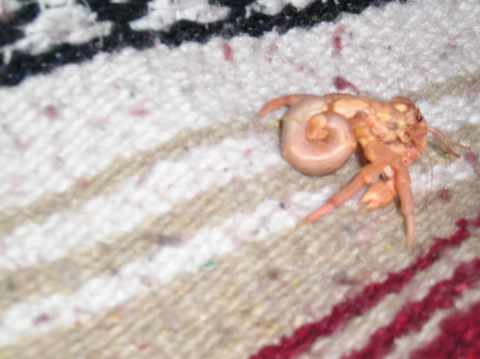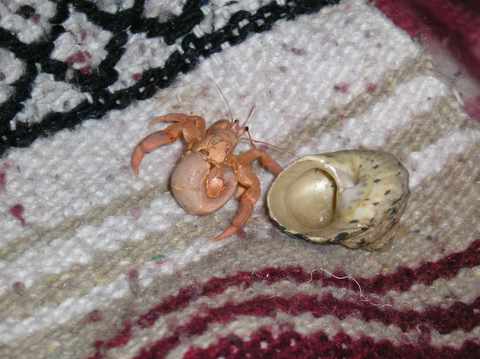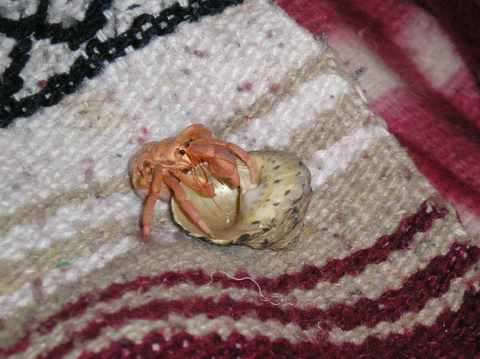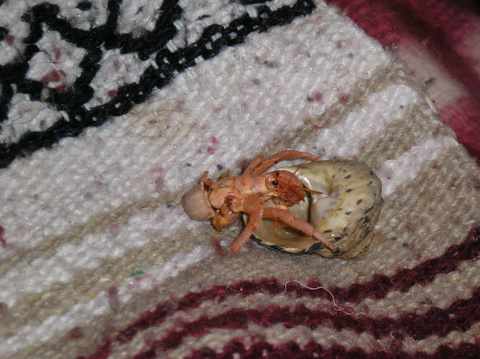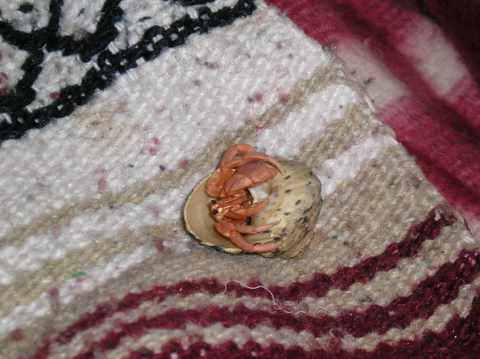



Hermit crabs of all species are distinctive because they have soft, curled abdomens that allow them to fit inside snail shells that act as both portable home and protection. The part of the crab that is most often outside of the shell is covered with the hard exoskeleton; the abdomen is shaped in a spiral, like the inside of the shell that the crab carries with it.
The abdomen is soft and covered with tiny blood vessels and can absorb moisture and oxygen from the air. The hermit crab breathes with these vessels and also with gills. In the back of the shell, where the abdomen is, the crab stores a small amount of water that it always carries with it, called "shell water." This keeps the moisture level inside the shell high, allowing the crab to breathe properly. Chlorine in tap water gradually dries out the shell-water and the abdomen, making it difficult for the crab to breathe, and rendering it inactive and could even lead to death.
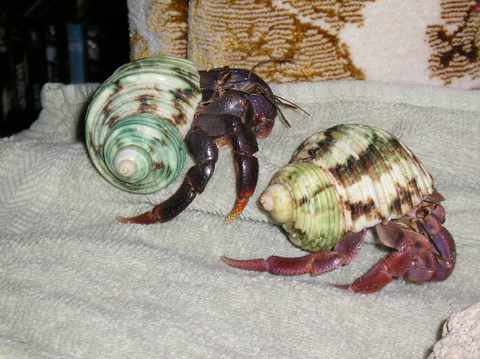
The tough exoskeleton on the "front" of the crab--the 'head,' with its eyes and antennae; the legs; and the claws, are the exposed parts we see as the crab walks around, eats, and drinks. When endangered, hermit crabs withdraw into their shells, leaving only the largest and thickest leg and the big claw exposed, effectively blocking the shell-opening and protecting their 'heads' and soft abdomens from attack. An attacker is faced with a wide-open claw that is ready to pinch!
Hermit crabs do not grow their own shells, as snails do. Instead, they "borrow" the abandoned shells of snails. As a hermit crab grows it must find bigger and bigger shells. Part of why there are far more small crabs to be found in the wild and in captivity is that the biggest shells are rare and therefore subject to high competition. Crabs will often fight over shells--especially in captivity. Part of your job as a crab-keeper is to provide them with plenty of empty shells so that there are many "homes" available to choose from.
You can usually buy shells where you bought your hermit crabs. Pet shops
will often have shells in different sizes and shapes available. When choosing
shells, pick ones that have the proper rounded opening (not a slit-shaped or
narrow opening) that hermit crabs' abdomens can fit inside. Select solid shells
that are free of holes and jagged edges along the front. When choosing a
shell that is bigger for a growing crab, make sure the shell opening is slightly
larger than the crab's big claw. After bringing the
shells home, make sure they are free of debris and cleanse them by boiling
them in hot water for a few minutes before placing them inside the hermit
crab tank.
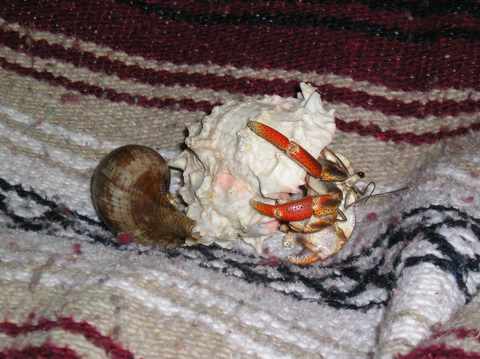
Hermit crabs examine a shell by literally wrapping themselves around it. They will explore the interior of the shell by inserting their claws and legs, making sure it's big enough for them, and also empty. Often they will turn the shell around and around with their legs, examining it carefully from every angle. When a crab is ready to switch shells, its own shell is propped slightly off the ground as it holds the new shell at the same angle, both shell-openings facing each other. The crab quickly switches shells, exposing its soft abdomen for the briefest time possible. Most often, the first thing the crab does in its new home is reach around and hold onto its new home, the same way it did when it was clinging to the new shell. Then you'll see your crab retract in and out of the new shell several times, adjusting its abdomen inside, making sure the shell is a good fit, and comfortable. If it's satisfied with its new home, it will let go of its old shell and walk away; in some cases, it will immediately switch back into its old home again. Shell-changing can take a minute or an hour, depending on how desperate the crab is for a new shell. Some crabs, comfortable in their shells, seem to use this as a form of entertainment; these will take their time and minutely examine the new shell, and usually return to their old shell when done.
Don't be alarmed if your crab actually likes to remain inside a shell that has a small hole in it, or is too small. Some crabs seem to love their shells and don't mind not being able to retract far inside them. A small hole doesn't seem to affect the shell-water at all; I've had a few crabs whose abdomens could actually be touched gently through the small holes near the base of the first big spiral. Even when provided with new shells, these crabs remained loyal to their old homes. Ideally, of course, every crab would be in a perfect shell, but I believe they have their own ideas about exactly what the perfect shell is.
Below is a sequence of a recently molted naked hermit crab named Digital moving into a shell. Note how Digital wraps her legs around the shell and examines it before quickly moving in--her choice was either "homeless" or "this shell" at this point in time.
